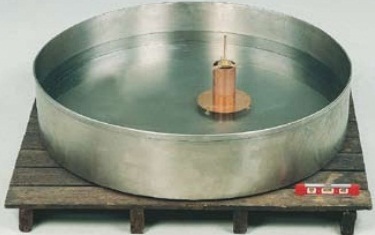Methods of Measurement of Evaporation
Definition of Rate of Evaporation
The rate of evaporation is defined as the amount of water evaporated from a unit surface area per unit of time. It can be expressed as the mass or volume of liquid water evaporated per area in unit of time, usually as the equivalent depth of liquid water evaporated per unit of time from the whole area. The unit of time is normally a day. The amount of evaporation should be read in millimeters (WMO, 2003). Depending on the type of instrument, the usual measuring accuracy is 0.1 to 0.01 mm.
The two methods for measurement of evaporation are:
- Direct methods
- Indirect methods
Direct methods of measurement of evaporation
i. Water budget technique:
This technique involves the maintenance of a water budget. Mathematically it is stated as
E = I - O ± ?S
E = Evaporation
I = inflow into soil reservoir
= Irrigation water + precipitation + incoming soil water contribution from surrounding + G.W
O = deep percolation (inside soil runoff)
? S = Change in storage
Now I = i + P + SFI + SSQ + GW
O = RO + SSQ + DP + L + E
ii. Lysimeter:
Definition:
A lysimeter is a measuring device which can be used to measure the amount of actual evapo-transpiration which is released by plants, usually crops or trees. By recording the amount of precipitation that an area receives and the amount lost through the soil, the amount of water lost to evapotranspiration can be calculated. Monolithic weigh-able lysimeters are a tool for water balance studies and solute transport determination.
Lysimeters are of two types:
- Weighing
- Non-weighing
iii. Pan evaporation
Discussed later
Indirect methods/empirical methods for evaporation's measurement
i. Aerodynamic method or Mass Transfer Method
Numerous empirical formulas have been derived which express evaporation as function of atmospheric element. But mostly they are based on Dalton's Law and are given as follows.
E = C [es - e] f(u)
C = constant
es = SVP
e = AVP
u = Wind speed
ii. Energy budget method:
Rn = E + A + S + C
Rn = Net radiation available energy from sun
E = energy used by evaporation
A = Energy used in heating air
S = Energy used in heating water
C = Energy used in heating the surrounding of water.
iii. Penman equation:
It is combination of aerodynamics and energy budget equations.
![]()
iv. Blaney criddle method:
Blaney Criddle expresses the consumptive use (evaporation) in terms of temperature and daytime hours. The modified equation by SCS is given as:
v. Jensen Haise method:
Based on energy balance equation. Approximately 1000 measurements of evapotranspiration over 35 year’s period at 20 locations in western US were made for this method/equation.

Climate data needed for it includes solar radiation; mean daily temperature and long term mean maximum air temperature for the month of highest mean air temperature and elevation above sea level.
vi. Hargreaves method:
Also called Hargreaves pan evaporation method. The standard National Weather Service class A pan is most widely used evaporation pan in the US. The evaporation pan of this standard set is made of stainless steel and has the dimensions of a “class A“ evaporation pan. The  evaporation pan is installed on the wooden support, which is set and levelled on the ground in a grassy location, away from bushes, trees and other obstacles which obstruct a natural air fow around the pan, thus representing open water in an open area.
evaporation pan is installed on the wooden support, which is set and levelled on the ground in a grassy location, away from bushes, trees and other obstacles which obstruct a natural air fow around the pan, thus representing open water in an open area.
ETo = Kp × Epan
Where Epan is the measured value of evaporation by US class A open
pan evaporimeter and Kp is pan coefficient.
Daily the result of evaporation and precipitation is measured within the still well, by means of a high quality evaporation micrometer with a measuring range of 100 mm and an accuracy of 0.02 mm. This accuracy can be obtained because the still well prevents rippling of the water surface. The amount of evaporation is a function of temperature, humidity, wind and other ambient conditions. In order to relate the evaporation to wind current or expected conditions, the maximum and minimum temperature as well as the amount of air passed are recorded with the evaporation. For a more exact use of the evaporation pan it is recommended to use an additional wind path meter.
Dimensions:
It is unpainted, galvanized iron of
- 120 cm in diameter
- 25.4 cm deep
Placed on wooden frame with its bottom 15cm above ground level. Water level is maintained between 5 and 7.5 cm minimum.
Advantages of Hargreaves method of Evaporations Measurement:
- Cheap and inexpensive
- Simple way of measuring evaporation
Disadvantages of Hargreaves method of Evaporation Measurement:
- Observations are made hourly, daily, weekly, and monthly
- Loss of water due to birds, animals and wind action must be prohibited.
- In this method, change in water level is the measure of evaporation.



